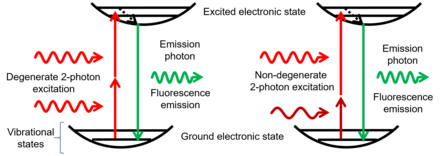Non-degenerate two-photon absorption

Non-degenerate two-photon absorption (ND-TPA or ND-2PA) [1] or two-color two-photon excitation[2] is a type of two-photon absorption (TPA) where two photons with different energies are (almost) simultaneously absorbed by a molecule, promoting a molecular electronic transition from a lower energy state to a higher energy state. The sum of the energies of the two photons is equal to, or larger than, the total energy of the transition.
The probability of ND-TPA is quantified as the non-degenerate two-photon absorption cross section (ND-TPACS) and is an inherent property of molecules. ND-TPACS has been measured using Z-scan (pump-probe) techniques,[3] which measure the laser intensity decrease due to absorption, and fluorescence-based techniques,[4] which measure the fluorescence generated by the fluorophores upon ND-TPA.
In ND-TPA, by absorbing the first photon, the molecule makes a transition to a virtual state and stays in the virtual state for an extremely short period of time (virtual state lifetime, VSL). If a second photon is absorbed during the VSL, the molecule makes a transition to the excited electronic state, otherwise it will relax back to the ground state. Therefore, the two photons are "almost" simultaneously absorbed in two-photon absorption. Based on the time–energy uncertainty relation, VSL is inversely proportional to the energy difference between the virtual state and the nearest real electronic state (i.e. the ground or a nearby excited state). Therefore, the closer the virtual state to the real state, the longer the VSL and the higher the probability of TPA. This means that in comparison to degenerate TPA, where the virtual state is in the middle of the ground and the excited state, ND-TPA has a larger absorption cross-section. This phenomenon is known as the and is the main mechanism behind the observed increase in ND-TPACS of semiconductors [5] and fluorophores[6][7] in comparison to their degenerate TPA cross-sections.
ND-TPA has also been explored in two-photon microscopy for decreasing out-of-focus excitation,[8] increasing penetration depth,[9] increasing spatial resolution,[10] and extending the excitation wavelength range.[11][12]
References[]
- ^ Hutchings, DC; Van Stryland, Eric W (1992). "Nondegenerate two-photon absorption in zinc blende semiconductors". JOSA B. 9 (11): 2065–2074. doi:10.1364/JOSAB.9.002065.
- ^ Lakowicz, Joseph R; Gryczynski, Ignacy; Malak, Henryk; Gryczynski, Zygmunt (1996). "Two‐Color Two‐Photon Excitation of Fluorescence". Photochemistry and Photobiology. 64 (4): 632–635. doi:10.1111/j.1751-1097.1996.tb03116.x. PMID 8863469. S2CID 29680279.
- ^ Negres, Raluca A; Hales, Joel M; Kobyakov, Andrey; Hagan, David J; Van Stryland, Eric W (2002). "Two-photon spectroscopy and analysis with a white-light continuum probe". Optics Letters. 27 (4): 270–272. doi:10.1364/OL.27.000270. PMID 18007776.
- ^ Sadegh, Sanaz; Yang, Mu-Han; Ferri, Christopher GL; Thunemann, Martin; Saisan, Payam A; Devor, Anna; Fainman, Yeshaiahu (2019). "Measurement of the relative non-degenerate two-photon absorption cross-section for fluorescence microscopy". Optics Express. 27 (6): 8335–8347. doi:10.1364/OE.27.008335. PMC 6825612. PMID 31052653.
- ^ Cirloganu, Claudiu M; Padilha, Lazaro A; Fishman, Dmitry A; Webster, Scott; Hagan, David J; Van Stryland, Eric W (2011). "Enhancement of two-photon absorption in quantum wells for extremely nondegenerate photon pairs". IEEE Journal of Quantum Electronics. 19 (23): 22951–22960. doi:10.1364/OE.19.022951. PMID 22109174.
- ^ Hales, Joel M; Hagan, David J; Van Stryland, Eric W; Schafer, KJ; Morales, AR; Belfield, Kevin D; Pacher, Peter; Kwon, Ohyun; Zojer, Egbert D; Br{\'e}das, Jean-Luc (2004). "Resonant enhancement of two-photon absorption in substituted fluorene molecules". The Journal of Chemical Physics. 121 (7): 3152–3160. doi:10.1063/1.1770726. PMID 15291625.
- ^ Sadegh, Sanaz; Yang, Mu-Han; Ferri, Christopher GL; Thunemann, Martin; Saisan, Payam A; Wei, Zhe; Rodriguez, Erik A.; Adams, Stephen R.; Kiliç, Kivilcim; Boas, David A.; Sakadžić, Sava; Devor, Anna; Fainman, Yeshaiahu (2019). "Efficient non-degenerate two-photon excitation for fluorescence microscopy". Optics Express. 27 (20): 28022–28035. doi:10.1364/OE.27.028022. hdl:2144/40818. PMC 6825618. PMID 31684560.
- ^ Kobat, Demirhan; Zhu, Guanghao; Xu, Chris (2008). "Background reduction with two-color two-beam multiphoton excitation". Biomedical Optics: BMF6. doi:10.1364/BIOMED.2008.BMF6.
- ^ Yang, Mu-Han; Abashin, Maxim; Saisan, Payam; Tian, Peifang; Ferri, Christopher; Devor, Anna; Fainman, Yeshaiahu (2016). "Non-degenerate 2-photon excitation in scattering medium for fluorescence microscopy". Optics Express. 24 (26): 30173–30187. doi:10.1364/OE.24.030173. PMC 5234507. PMID 28059294.
- ^ Ibáñez‐López, Cristina; Escobar, Isabel; Saavedra, Genaro; Martinez-Corral, Manuel (2004). "Optical-sectioning improvement in two-color excitation scanning microscopy". Microscopy Research and Technique. 64 (2): 96–102. doi:10.1002/jemt.20073. PMID 15352080. S2CID 1376871.
- ^ Quentmeier, S; Denicke, S; Gericke, K-H (2009). "Two-color two-photon fluorescence laser scanning microscopy". Journal of Fluorescence. 19 (6): 1037–43. doi:10.1007/s10895-009-0503-x. PMID 19590940. S2CID 27266538.
- ^ Mahou, Pierre; Zimmerley, Maxwell; Loulier, Karine; Matho, Katherine S; Labroille, Guillaume; Morin, Xavier; Supatto, Willy; Livet, Jean; D{\'e}barre, Delphine; Beaurepaire, Emmanuel (2012). "Multicolor two-photon tissue imaging by wavelength mixing". Nature Methods. 9 (8): 815–818. doi:10.1038/nmeth.2098. PMID 22772730. S2CID 33436269.
- Nonlinear optics